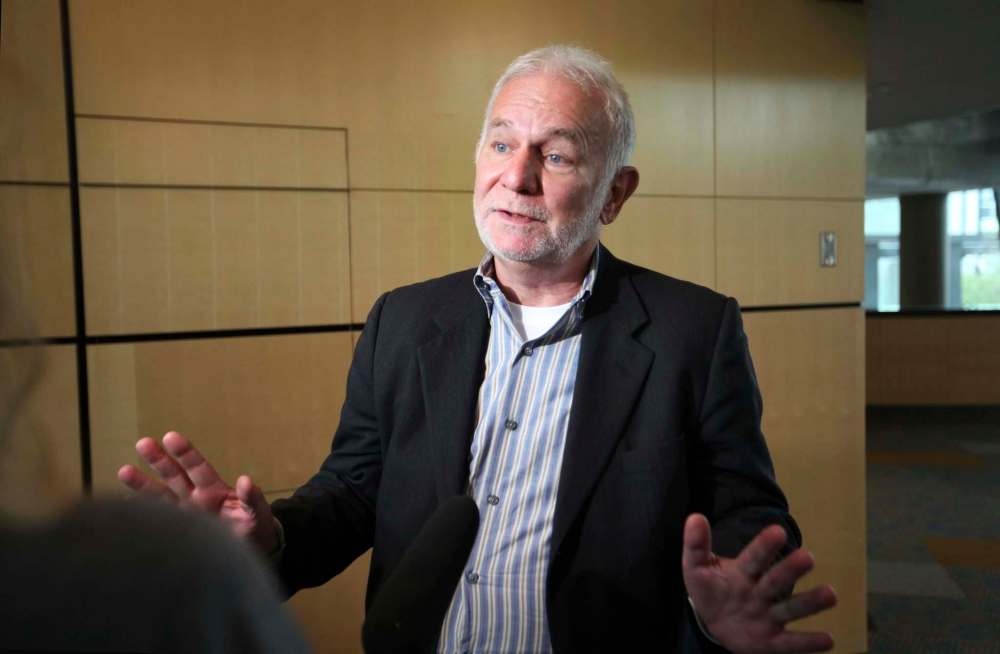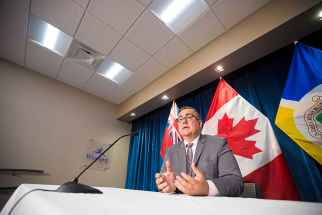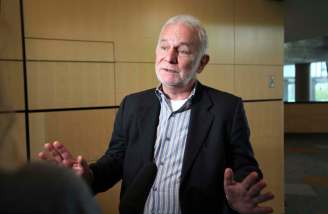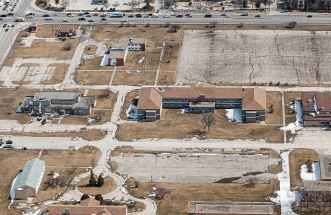Dispelling a few myths about the Peachey report
Read this article for free:
or
Already have an account? Log in here »
To continue reading, please subscribe:
Monthly Digital Subscription
$0 for the first 4 weeks*
- Enjoy unlimited reading on winnipegfreepress.com
- Read the E-Edition, our digital replica newspaper
- Access News Break, our award-winning app
- Play interactive puzzles
*No charge for 4 weeks then price increases to the regular rate of $19.00 plus GST every four weeks. Offer available to new and qualified returning subscribers only. Cancel any time.
Monthly Digital Subscription
$4.75/week*
- Enjoy unlimited reading on winnipegfreepress.com
- Read the E-Edition, our digital replica newspaper
- Access News Break, our award-winning app
- Play interactive puzzles
*Billed as $19 plus GST every four weeks. Cancel any time.
To continue reading, please subscribe:
Add Free Press access to your Brandon Sun subscription for only an additional
$1 for the first 4 weeks*
*Your next subscription payment will increase by $1.00 and you will be charged $16.99 plus GST for four weeks. After four weeks, your payment will increase to $23.99 plus GST every four weeks.
Read unlimited articles for free today:
or
Already have an account? Log in here »
Hey there, time traveller!
This article was published 28/06/2019 (2360 days ago), so information in it may no longer be current.
The next provincial election is still more than two months away, but one thing has become abundantly clear: this will be an election fought on the future of the province’s health-care system.
In a way, you can thank Dr. David Peachey for that.

Commissioned in 2015 and delivered in early 2017, his seminal report — Provincial Clinical Services Planning for Manitoba — kicked off an overhaul of health care infrastructure that many believe is the most far-reaching in this province’s history.
And yet, there is still a lot that is not known about the Peachey report and efforts by the Winnipeg Regional Health Authority to implement its recommendations. That lack of knowledge has made the changes being implemented right now — the recent closure of the Concordia ER and the forthcoming closure at Seven Oaks Hospital — a huge concern both for voters and the Tory government that will be seeking their support this fall.
For voters, there is an immediate need for clarity on what the report actually recommended, how it has been implemented and what mistakes have been made.

Much of that clarity rests with Réal Cloutier, the WHRA’s president and CEO. Cloutier took over the top administrative post at the WRHA right as the Progressive Conservative government was staking much of its political capital in Winnipeg on delivering some of the changes outlined in the Peachey report.
In a recent interview, Cloutier agreed to discuss some the myths and miscommunication that have accompanied the implementation of the Peachey recommendations.
Peachey is about what, not how.
One of the biggest misconceptions about the Peachey report is the belief that in addition to describing “what” the provincial government should do to modernize its health care system, it also describes “how” it should be done.
Like many consultants, Peachey was primarily interested in the things the province needed to do to improve performance and outcomes in the health-care system. Cloutier confirmed that Peachey was not initially involved in the “how,” which was left entirely up to the WRHA.
Peachey was not asked to redesign health-care services in Winnipeg; he was asked to create a province-wide plan.
Cloutier said one of the fundamental misconceptions about the Peachey report, and the work of the WRHA, is that this is solely a process focused on Winnipeg. In fact, Peachey laid out a blueprint for the overhaul of health-care services on a province-wide basis.
“What you’re seeing and reading in the media is about the visible changes here in Winnipeg,” Cloutier said. “What we have yet to see are (changes) in the rest of the province that support that changes that Winnipeg has made.”
However, the restructuring of health-care services outside Winnipeg is being managed on an entirely different schedule through an entirely different government organization. Shared Health, which was not formally created until months after the WRHA launched its reorganization of Winnipeg hospitals, will ultimately implement Peachey’s recommendations outside the province’s capital.
The disconnect between those two processes, which is the result of planning by the provincial health department and not the WRHA, has no doubt created more stress on the WRHA as it attempts to reduce the number of emergency departments.
It also explains why dozens of Peachey’s recommendations have not been implemented at all. Many, such as a massive increase in the number of physician assistants and nurse practitioners, have been left unattended for the time being.
Peachey is not about cost-cutting, per se; it is an attempt to wean us off our dependance on hospitals.
One of the biggest flaws in Canada’s universal health-care system is that hospitals, essential for certain kinds of care, are routinely overrun with patients who could — and should — be getting care through other, more cost-effective options.
“When you think about it, we’ve created a health care system that funnels everything to the emergency department,” said Cloutier. “That’s is not a well-balanced, well-functioning health-care system…. I think people visibly identify with their hospitals but … we can’t afford a model of having multiple hospitals being able to provide every specialty service deliverable.”
Pre-Peachey, some of Winnipeg’s six ERs were missing the staff or the facilities to do everything that a modern emergency department needs to do. That meant a rising number of costly and risky patient transfers. The Peachey plan envisioned three fully staffed, fully equipped ERs and three 24-hour/seven-day Urgent Care (UC) centres.
Initially, the WRHA elected to go with three ERs and only two UCs. Concordia was ultimately upgraded to a UC status. There is a lot of evidence to suggest that a balanced model with three ERs and three UCs is reasonable, even if it has raised the alarm for people living in areas where emergency departments have been closed.
The WRHA has not received any additional funding to implement the Peachey report.
Although the Tory government did provide $20 million in capital funds to help expand and renovate hospitals to handle the reconfiguration of services, the WRHA got no additional money to support operational changes.
When asked about whether this was a prudent approach, Cloutier would only say the WRHA has been able to manage the changes recommended by Peachey “within our budget.” However, there is no doubt that many of the flashpoints of concern about the hospital reorganization plan have been related to the rapid pace of change, which appears to be largely driven by the need to get the changes made as quickly and cost-effectively as possible.
Questions remain about whether the hospital system will have the capacity to meet future needs.
A common assertion made by WRHA officials is that recent crowding at Winnipeg hospitals is not the result of an increase in patients, but an increase in the severity of the health problems presented by those patients.
In the interview, Cloutier said total ER arrivals are stable, but more of the people are sicker, many with serious respiratory ailments that require admission. When too many exceedingly sick patients arrive at an ER and require admission, the entire system backs up. That’s what happened at St. Boniface Hospital earlier this month, when it had to close its ER to new patients.
At the very least, Winnipeggers need to know that the province is building a health care system with enough capacity to serve a growing city population with — as it appears now — an increase in severity of illness. A full year before the hospital reorganization has been fully implemented, it appears Winnipeg does not have the capacity to handle those surges.
Boil all these essential truths down and you have this: a bold and ambitious plan to reorganize health care services that has been implemented in a piecemeal fashion without any additional resources to help ease Manitobans into a new age in which hospitals are no longer the main point of access.
The essence of Peachey — which is to shift primary care away from ERs to what the WRHA calls “walk-in connected care” — is likely very sound. In many ways, it is arguably the health-care system we need, even if it’s not the health care we might want.
But it can only fulfil that aspiration if the implementation is managed properly. The Tory government, and the WRHA, still have work to do to convince voters that this is still a good idea, and that it’s being implemented the right way.
dan.lett@freepress.mb.ca

Born and raised in and around Toronto, Dan Lett came to Winnipeg in 1986, less than a year out of journalism school with a lifelong dream to be a newspaper reporter.
Our newsroom depends on a growing audience of readers to power our journalism. If you are not a paid reader, please consider becoming a subscriber.
Our newsroom depends on its audience of readers to power our journalism. Thank you for your support.
History
Updated on Saturday, June 29, 2019 9:16 AM CDT: Corrects timeframe reference.


















